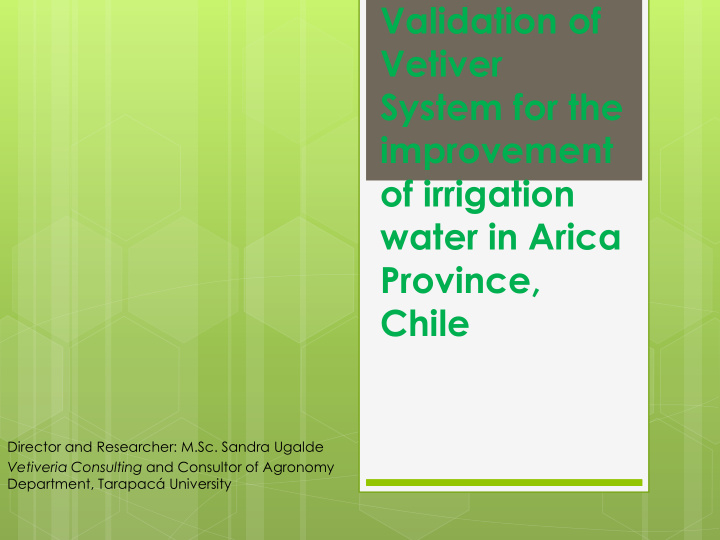



Validation of Vetiver System for the improvement of irrigation water in Arica Province, Chile Director and Researcher: M.Sc. Sandra Ugalde Vetiveria Consulting and Consultor of Agronomy Department, Tarapacá University
Project sponsored by the Foundation for Agricultural Innovation, Ministry of Agriculture Implemented by Tarapacá University Director and Researcher: M.Sc. Sandra Ugalde, Vice Director: Vitelio Goykovic Special collaboration: Paul Truong, TVNI. Brisbane, Australia Brad Gradley, Leachate Management Specialist, Denver, USA
OBJECTIVES To validate the remediation efficacy of vetiver in waters contaminated with boron, arsenic and heavy metals. To introduce new crops sensitive to boron in the Lluta valley (irrigated with remediated water)
VALLEYS IN ARICA PROVINCE The valleys of Arica Parinacota Province in Northern Chile present outstanding climatic conditions that allows crop production all year long, the province is the supplier of fresh vegetables for both central and southern Chile during winter, placing Arica´s valleys as one of the key factors in food security, specially Azapa valley which has excellent water quality producing 3,2% of the national total for horticulture.
The valleys on Arica are inserted in a desert region where salinity, boron and arsenic are in high concentrations in rivers, as well as in soil, as in the Lluta Valley soil can reach 40 mg boron/L, while the Lluta River can reach 23 mg boron/L
Total of 7.000 ha in the Lluta Valley, only 2.700 ha cultivated Only crops to grow: Corn var. Lluteño (ecotype), Alfalfa var. alta sierra, beets, brocoli and onios
Vetiver growing on a Boron contaminated soil (35 mg/l) and irrigated with water high in B (16 mg/l), Arica Province
Boron toxicity for crops Very sensitive (< 0,5 mg/l): lemon; sensitive (0,50 - 0,75 mg/l): avocado, grapefruit, orange, apricot, peach, onion; moderadatly sensitive (1,00 - 2,00 mg/l): garlic, wheat, strawberry, bean;
moderatly tolerants (2,00 - 4,00 mg/l): lettuce, cabage, corn, artichoke; tolerants (4,00 - 6,00 mg/l): tomato, alfalfa, beets; very tolerants (6,00 - 15,00 mg/l): cotton, aspargus.
A field experiment was established to introduce 4 new crops and irrigated with Vetiver remediated water, the boron level decreased by 1.5 to 2.5 mg/L. Melons Lettuce Sweet corn Chilli pepper var. Cristal None of this crops are able to grow in soil high in boron
BORON IN IRRIGATION WATER Boron decreased 21.5% average (7 a 5.5 mg/L per 2-4 days)
Tendency of Boron Phytoremediation in Water with Different Biomass
Sweet corn Lower boron in irrigation water allowed the crops to grow with high to good yields
All corn was extra quality in this trial. While the Azapa valley has only first and second quality
Lettuce; first quality Yields were equal to others valleys (Azapa valley) in the Province where there is no boron contamination
Melon; second quality
Chilli peppers; extra and first quality
Residual As concentration in water (mg/L) at different sampling periods (n=6). T1 (600 g biomass), T2 (1000 g biomass). + Mean values within the same column denoted by different letters are significantly different ( P < 0.05) according to Duncan´s range test. * P < 0.05, **P <0.01. NS; not significant
Bore water from Lluta valley; Arsenic level reduced from 0.33 mg/L to 0.06 mg /L after 5 days
Residual lead and manganese concentration in water (mg/L) at different sampling periods (n=6) +Mean values denoted by different letters are significantly different (P < 0.05) according to Dunnett t test. ** P < 0.01; * P < 0.05; ND: not detectable
Test in Soil 100 mg B/L 50 mg B/L 1 mg B/L 20 mg B/L Vetiver was irrigated with these concentrations during 3 months
50 mg B/L 100 mg B/L
Removal Efficiency Percentage in Boron at different sampling periods after planting. T1, 1 mg/L; T2, 20 mg/L; T3, 50 mg/L and T4,100mg/L. + Mean values within the same column denoted by different letters are significantly different ( P < 0.05) according to Duncan´s range test. * P < 0.05, **P <0.01. NS; not significant
Translocation Factor for Boron (mg/kg) T1 T2 T3 T4 Leave 187,4 267,7 312,9 350,3 Root 19,8 81,7 117,3 175,5 TF 9,48 3,28 2,67 2,00 T1, 1 mg/L; T2, 20 mg/L; T3, 50 mg/L and T4,100mg/L.
CONCLUSION Vetiver can improve agriculture production in the Arica Province by remediating soil and water from Boron toxocity. This results in the development of 3.000 ha that are currently not being used due to boron toxicity. Also will contribute to the increase in yields of existing crops in the Lluta Valley
Recommend
More recommend